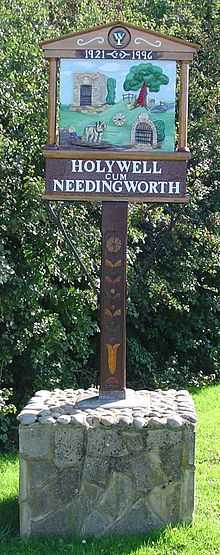Holywell, Cambridgeshire
Coordinates: 52°19′08″N 0°02′02″W / 52.319°N 0.034°W

Holywell is a village in the Huntingdonshire district of Cambridgeshire), England. It is half a mile south of Needingworth, and east of St Ives.
The holy well
The holy water well from which the village takes its name is located in front of the church, as you exit the building with the River Great Ouse ahead of you. It has been refurbished and repaired many times over the years. The "well" is in fact a stone structure built over a natural spring which emerges at this point. There are several other natural springs, or chalybeates, along Holywell Front; water seeps out under the gravel bank where it meets the underlying clay. A well dressing ceremony takes place each year in June, and children from the local primary school are involved in making floral garlands and decorations for the well.
The existence of a church on the site dates back further than reliable records exist, but there is a register of church rectors dating back to AD 990. The living was in the gift of the Abbot of Ramsey, and there remains at the west end of the village evidence of mediaeval fishponds which were managed by monks from the Abbey. The current church building is mainly 14th century, with a fine 16th-century tower reputedly built with stone taken from Ramsey Abbey after the Dissolution.
The village
Holywell is a Saxon ring village, one of only three in Cambridgeshire. It is served by a small road from Needingworth and is a dead-end to motor traffic. There are approximately 80 houses, the oldest dating to the 16th century, a parish church and a public house in the village.
The road at the southern aspect faces onto farmland and the River Great Ouse. The river levels are regulated by a system of locks and sluices, and after heavy rains the river is allowed to flood across the large area of meadows on Holywell Front to a depth of several feet, often covering the road. Access to the houses, which are all in an elevated position on a gravel bank running roughly east-west, is via a footpath or access track from the northern side of the village.
The legends
Legend has it that a young girl named Juliet committed suicide near the church in the time of Edward the Confessor. The story runs that she committed the act having been jilted in love by the local woodcutter, and was thus buried on the banks of the Ouse at the ferry crossing point in AD 1050. It is claimed the Old Ferry Boat Inn public house was built on top of her grave. A stone slab can be found within the pub, set into the floor on the south west side of the pub.
A seance was conducted in the 1950s, during which the participants claim to have contacted the spirit of the young girl. During questioning, she apparently identified herself as Juliet Tewsley and that the local woodcutter was named Thomas Zoul. However, no Norman records have been found to support this claim. During a second seance the following year, the date moves forward to the 15th century.
On the anniversary of her death, which coincidentally is St. Patrick's day (17 March, according to tradition) her ghost appears as a spectral figure slowly moving towards the river bank. Occasionally the apparition has been witnessed within the Ferry Boat Inn, but this may relate to the themed evening hosted inside, and the alcoholic drink promotions of the night. The gravestone of the above-mentioned Juliet is preserved within the pub, but to walk on it is to invite serious ill-luck and drinks must be bought for all and sundry within should a visitor do so. A number of paranormal groups investigate the Inn on the 17 March but evidence is generally inconclusive.
The pub
The Old Ferry Boat Inn (or Ye Olde Ferry Boat Inn) is one of the greatest attractions to the village. It is a large public house with restaurant, conference rooms and seven large bedrooms available to the public. Over the years it has grown from a small local labourers tavern into the commercially profitable venue that it is now. The inn, and other buildings in and around Holywell, were the subject of paintings by the watercolour artist W. F. Garden (Garden William Fraser), who lived at the Old Ferry Boat from 1904 until his death in 1921.[1] It has been owned by various families, breweries and private concerns and is seen as a jewel-in-the-crown to brewing outfits due its picture postcard looks and large visitor numbers. It is currently serviced by the Greene King chain.
The Ferry Boat Inn is one of scores of pubs in the UK to lay claim to being the country's oldest. Others include Ye Olde Trip to Jerusalem, Nottingham and Ye Olde Fighting Cocks, St Albans.
References
- ↑ The Fraser Family. Charles Lane. Publ. Chris Beetles, 2010
